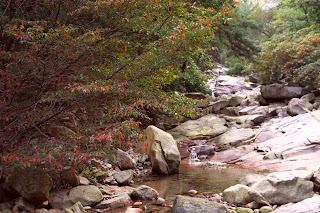At 629 meters, Gwanaksan (관악산) is smaller than it's northern counterpart, Bukhansan, but nevertheless, because of it's rocky peaks, some cliffs and many rugged trails, it is a little hiking paradise in the southern side of Seoul. On the mountain lie numerous Buddhist temples, shrines and hermitages, making it a nice refuge for people escaping city life.
How to get there
Gwanaksan is easily accessible via public transportation (Official Site of Tourism). I took the subway to the Seoul National University station (line 2), Exit3. From there I took a bus (no. 5515) towards the university entrance. You can't really miss it as you just need to follow the other people wearing hiking clothes. Alternatively you can start from Gwacheon station (line 4), but that is where I planned to end my hike.
My hike
In the very beginning, after passing the university campus, the trail passes through Lake Park, which is a small park with an artificial pond, an island and the mandatory wooden bridges. I guess this is a good place for the student couples to have their first romantic dates.
The trail itself is not too steep in the beginning and takes you next to some small streams of water (I guess in the days after rainfall, the streams will carry much more water). The terrain is a bit rugged from time to time, so I definitely recommend to wear some good hiking shoes, as there are certainly some places where you could easily sprain your ankle. Later on it gets more and more steep, but like in most other parks in Korea, here and there are some stairs installed (or ropes to hold on too).
The trail itself is not too steep in the beginning and takes you next to some small streams of water (I guess in the days after rainfall, the streams will carry much more water). The terrain is a bit rugged from time to time, so I definitely recommend to wear some good hiking shoes, as there are certainly some places where you could easily sprain your ankle. Later on it gets more and more steep, but like in most other parks in Korea, here and there are some stairs installed (or ropes to hold on too).
 |
| Trail near beginning |
 |
| Some steeper parts close to weather station |
Besides temples, near the top, you will see some radio towers around, luckily not disturbing the view too much. Centerpiece is an (almost) spherical weather station.
 |
| Weather station near the top. |
What most people are coming for (including me) is actually the inspiring sight on the Yeonjudae Hermitage, which is placed carefully on the edge of a cliff. The hermitage was built in 677 in the Silla Period by a Buddhist priest called Uisang (to which the hermitage was originally named). It changed its name later to Yeonjudae after founding of the Joseon dynasty, by the people that missed the perished Kingdom of Goryeo.
 |
| Yeonjudae Hermitage |
 |
| Yeonjudae Hermitage as seen from the weather station |
 |
| View inside |
 |
| 180 degree panorama from the area |
After a short rest, enjoying the different view from the top and re-energizing myself with some food, I headed back down, but now keeping left on the track. This would lead me towards Gwacheon station.
 |
| Early autumn scenery |
I really had a great day today on Gwanaksan and I guess it is only becoming to be more beautiful in the next weeks, with more autumn colors. Unfortunately, I will not be around in Seoul then, but well... I have something else to look forward to: Seoraksan national park.




























